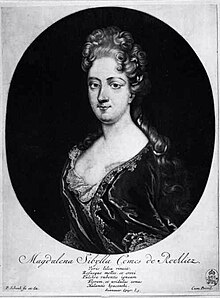Magdalena Sibylla von Neitschütz
Magdalena Sibylla von Neitschütz (* February 8, 1675 , † April 4, 1694 in Dresden ) was mistress of the Saxon Elector Johann Georg IV , at whose instigation she rose to the rank of Countess of Rochlitz .
family
Magdalena Sibylla was the daughter of Colonel and later Lieutenant General Rudolf von Neitschütz (1627–1703) and his wife Ursula Margarethe von Haugwitz ("the General", 1650–1713), the sister of Oberhofmarschall Friedrich Adolph von Haugwitz (1637–1705). Rudolf von Neitschütz served as a major and from 1673 as colonel of the electoral prince's bodyguard on horseback before he was promoted to lieutenant general in 1686.
Since Ursula Margarethe had a familiar relationship with the Elector Johann Georg (III.) Even before her marriage and her husband is said to have been on a Rhine campaign in the spring of 1674 (and Johann Georg allegedly not), the rumor arose that Magdalena Sibylla was an illegitimate daughter of the electoral prince. It was nourished by the fact that the child was given the first names of the mother and grandmother of the elector.
Life
Magdalena Sibylla grew up in the vicinity of the Saxon court, as her parents had their job and residence in Dresden or preferred court life to life on their estates in Upper Lusatia. She was called to the castle by the Electress Anna Sophie (1647–1717) occasionally as a companion and in 1687 met Prince Elector Johann Georg (IV) , who stayed in Dresden after returning from the then usual gentlemanly journeys and fell in love with her.
The resulting love affair was initially suppressed by the electoral couple with a series of measures, which included taking the prince on the new Rhine campaign (1689, 1691) and arranging a trip to Italy (1690), as well as the dishonorable dismissal of the (at the Affair uninvolved) Rudolf von Neitschütz.
When Johann Georg IV ascended the throne in 1691, Magdalena Sibylla, as mistress (Johann Georg IV even personally set up a “marriage alliance” on October 19, 1691), managed to gain considerable influence at court for herself and her family in a very short time. She represented next to the official wife Eleonore von Sachsen-Eisenach and tried to give her environment important posts or to support her by making payments from third parties to the elector.
On February 4, 1693, at the instigation of the elector, she was raised to Countess of Rochlitz by means of bribes of 40,000 thalers and 12,000 auxiliary troops for Emperor Leopold I. In addition, the elector gave her the Pillnitz manor (1694) and the later Fürstenbergsche Haus in Dresden (1692), along with other goods and properties .
In the autumn of 1693, however, she began to show serious signs of illness, which led to her being bedridden from March 1694 and finally to death on April 4, 1694 at the age of 19. Officially, smallpox is the cause of death, but according to the epidemic files, no smallpox epidemic was recorded in Saxony at the time. She was initially buried in the crypt of the Sophienkirche .
The elector Johann Georg IV died a few weeks later.
Posthumous witch trial
Johann Georg's brother and successor, Friedrich August I , instigated a posthumous witchcraft trial against the Neitschütz family and their followers (with a view to public opinion and his finances) and had the coffin opened to examine Magdalena Sibylla's remains for signs of witchcraft allow. Her body was then buried anonymously. Ursula Margarethe was tortured (in the first degree, i.e. with gangs and thumbscrews) and after her imprisonment at Königstein Fortress (until November 1699, because of unlawful enrichment), she was banished to her property. The possessions of Magdalena Sibyllas and Ursula Margarethes were confiscated. Alleged accomplices of lower rank were severely tortured and punished.
progeny
In June 1693 she gave birth to Johann Georg IV. In Frankfurt a daughter, Wilhelmine Marie Friederike von Rochlitz († around 1760), whom the elector contractually legitimized and for whom the English royal couple Wilhelm III. and Maria II took over the sponsorship. She was married to Count Piotr Świętosław von Dunin , Castellan zu Radom († 1736) in 1721 , and had five children.
Coat of arms of the Countess of Rochlitz
Magdalena Sibylla received an extended coat of arms from the emperor when she was raised to the rank of imperial countess: the shield is quartered, in fields 1 and 4 the family coat of arms of those of Neitschütz , in fields 2 and 3 three black rays (Grafschaft Rochlitz) in gold. On it the Saxon diamond wreath coat of arms as a heart shield.
literature
- Andrea Martin: Magdalena Sybilla von Neitschütz - beloved at the court of Electoral Saxony , Taucha 2010.
- Hans-Joachim Böttcher : Johann Georg IV. Von Sachsen & Magdalena Sibylla von Neitschütz , Dresden 2014, ISBN 978-3-941757-43-1 .
Web links
- Rochlitz . In: Heinrich August Pierer , Julius Löbe (Hrsg.): Universal Lexicon of the Present and the Past . 4th edition. tape 14 . Altenburg 1862, p. 213 ( zeno.org ).
- Heinrich Theodor Flathe: Johann Georg IV. In: General German Biography (ADB). Volume 14, Duncker & Humblot, Leipzig 1881, pp. 384-386.
- Documents concerning Magdalena Sibylla von Neitschütz and the trial of her mother, Ursula Margarethe von Neitschütz manuscript
Individual evidence
| personal data | |
|---|---|
| SURNAME | Magdalena Sibylla von Neitschütz |
| ALTERNATIVE NAMES | Magdalena Sibylle von Neitschütz; Magdalene Sibylle von Neitschütz |
| BRIEF DESCRIPTION | Countess of Rochlitz, mistress of Johann Georg IV of Saxony |
| DATE OF BIRTH | February 8, 1675 |
| PLACE OF BIRTH | uncertain: Dresden |
| DATE OF DEATH | April 4, 1694 |
| Place of death | Dresden |
